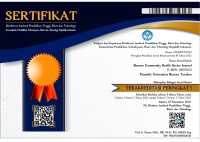Edukasi Masyarakat Siaga (Emas) 1.000 Hari Pertama Kehidupan
Abstract
Stunting is a condition of failure to thrive in children under five years old due to chronic malnutrition, especially during the first 1000 Days of Life (1000 HPK). Stunting affects brain growth and development. Stunted children also have a higher risk of suffering from chronic diseases in adulthood. Based on the results of the 2021 SSGI, the prevalence of stunting in Nunukan Regency is the highest in North Kalimantan, reaching 30%. Among the 17 primary healthcare service areas under the Nunukan district health office, the Sedadap primary healthcare service area has one of the highest incidence rates of stunting. Out of 1,817 measured toddlers, 267 (14.7%) were found to be stunted. This is suspected to be due to the lack of knowledge among the cadres and the community about the 1000 HPK concept, insufficient knowledge among cadres and pregnant women about meeting the nutritional needs of toddlers, and partners not knowing about the use of the Kuesioner Pra Skrining Perkembangan (KPSP) as an early detection and screening tool for toddlers' status and development. The proposed solutions to these issues are the provision of education and assistance in filling out the KPSP. The training method employed includes interactive lectures and direct demonstration practices, while the mentoring process involves periodic monitoring to ensure the successful and sustainable implementation of the program. Overall, this community partnership program is a positive step towards preventing stunting. Education, child development monitoring, and mentoring are essential components that have effectively increased the knowledge and awareness of the community. Through understanding and appropriate actions, stunting issues in toddlers can be minimized, enabling future generations to grow and develop optimally.
Keywords
Full Text:
PDFReferences
Adani, F. Y., & Nindya, T. S. (2017). Perbedaan Asupan Energi, Protein, Zink, dan Perkembangan pada Balita Stunting dan non Stunting. Amerta Nutrition. https://doi.org/10.20473/amnt.v1i2.2017.46-51
Alfarisi, R., Nurmalasari, Y., & Nabilla, S. (2019). STATUS GIZI IBU HAMIL DAPAT MENYEBABKAN KEJADIAN STUNTING PADA BALITA. Jurnal Kebidanan Malahayati. https://doi.org/10.33024/jkm.v5i3.1404
Anjani, S. I. (2022). FAKTOR-FAKTOR PENENTU SEBAGAI DETERMINAN ANAK STUNTING DI INDONESIA. Nutrix Journal, 6(1). https://doi.org/10.37771/nj.vol6.iss1.689
Gusriani, E. W., Kebidanan, J., Kesehatan, F. I., Tarakan, U. B., & Optimalisasi, P. K. (2022). PRODUK DIVERSIFIKASI OLAHAN IKAN LELE UNTUK PENINGKATAN GIZI BALITA KAYA AKAN OMEGA 3 , OMEGA 6 DAN OMEGA 9 SISWA SMK NEGERI 1 SEBATIK DIVERSIFICATION OF PROCESSED CATFISH PRODUCTS FOR INCREASING NUTRITION FOR TOddlers RICH IN OMEGA 3 , OMEGA 6 AND OMEGA . 63–67.
Gusriani, G., & Octamelia, M. (2023). PENYULUHAN DAN PELATIHAN PEMBUATAN COOKIES TEPUNG DAUN BAYAM DURI DAN TEPUNG DAUN KATUK UNTUK IBU MENYUSUI COUNSELING AND TRAINING AMARANTHUS SPINOSUS LEAF AND SAUROPUS ANDROGYNUS LEAF FLOUR COOKIES FOR BREASTFEEDING MOTHER 5 Jurusan Keperawatan Universit. IX(1), 19–23.
Gusriani, G., & Wahida, W. (2023). Pelatihan dan Pendampingan Edukasi Teknik Menyusui pada Kader Pendahuluan. 3(1), 30–35.
Gusriani, G., Wahida, W., & Noviyanti, N. I. (2023). Status Gizi Ibu dan Persepsi Ketidakcukupan Air Susu Ibu. Kesmas: National Public Health Journal, 2(1), 249. https://doi.org/10.21109/kesmas.v6i6.77
Hendrayati, & Asbar, R. (2018). Faktor Determinan Kejadian Stunting. Media Gizi Pangan, 25(1).
Kemenkes RI. (2018). Buletin Stunting. Kementerian Kesehatan RI.
Kemenkes RI. (2022). Profil Kesehatan Indonesia 2021. In Pusdatin.Kemenkes.Go.Id.
Kementerian Kesehatan Republik Indonesia. (2018). Intervensi stunting terintegrasi awal wujudkan indonesia bebas stunting. Kementerian Kesehatan Republik Indonesia.
Pusdatin Kemenkes RI, 2017. (2017). Pusdatin Kemenkes. Journal of Chemical Information and Modeling.
Rahmadhita, K. (2020). Permasalahan Stunting dan Pencegahannya. Jurnal Ilmiah Kesehatan Sandi Husada. https://doi.org/10.35816/jiskh.v11i1.253
RI, K. (2018). profil Kemenkes RI. In Kementerian Kesehatan RI.
RI, K. K. (2022). Status Gizi SSGI 2022.
Rilyani, R. (2021). Exclusive Breastfeeding with the Incidence of Stunting in Toddlers. Jurnal Ilmiah Kesehatan Sandi Husada. https://doi.org/10.35816/jiskh.v10i1.489
Tampubolon, D. (2020). KEBIJAKAN INTERVENSI PENANGANAN STUNTING TERINTEGRASI. Jurnal Kebijakan Publik. https://doi.org/10.31258/jkp.11.1.p.25-32
Wahida, W., Gusriani, G., & Noviyanti, N. I. (2022). EDUKASI KESEHATAN TENTANG ANEMIA PADA REMAJA PUTRI. Jurnal Pengabdian Masyarakat Borneo, 6(3). https://doi.org/10.35334/jpmb.v6i3.2909
WHO. (2018). Stunting Policy Brief. In Department of Nutrition for Health and Development World Health Organization. https://doi.org/10.7591/cornell/9781501758898.003.0006
DOI: https://doi.org/10.35334/neotyce.v3i2.4216
Refbacks
- There are currently no refbacks.

This work is licensed under a Creative Commons Attribution-ShareAlike 4.0 International License.
Borneo Community Health Service (NEOTYCE) Journal Indexed by:
Indexed by:
Borneo Community Health Service (NEOTYCE) Journal
FAKULTAS ILMU KESEHATAN UNIVERSITAS BORNEO TARAKAN
JL. AMAL LAMA, NOMOR 1, KELURAHAN PANTAI AMAL, KOTA TARAKAN 77123
Phone : (+62)82188737351
Email :bchs@borneo.ac.id
Laman : http://jurnal.borneo.ac.id/index.php/NEOTYCE

.png)





